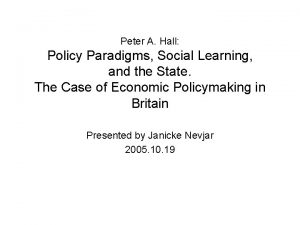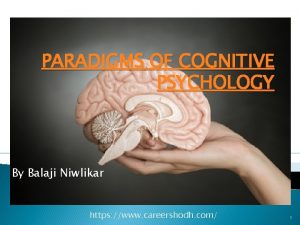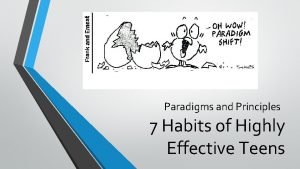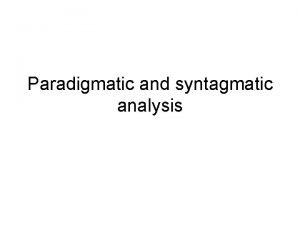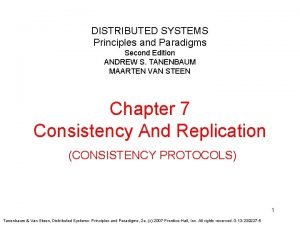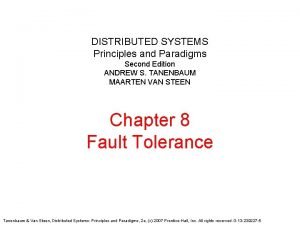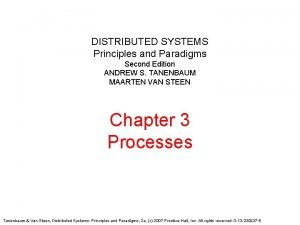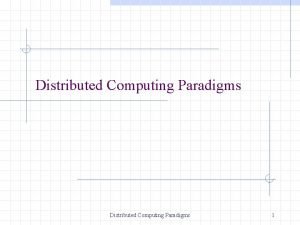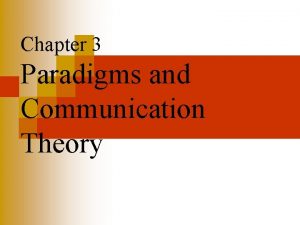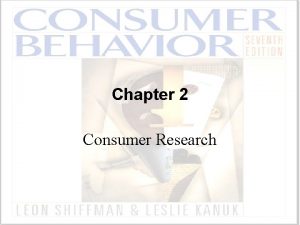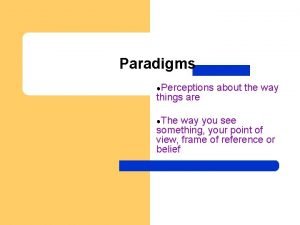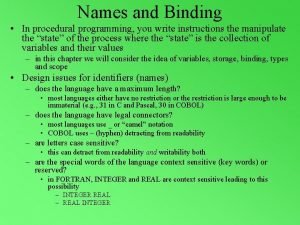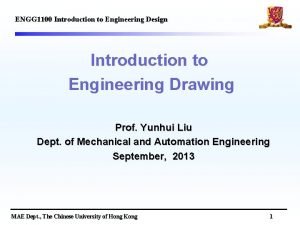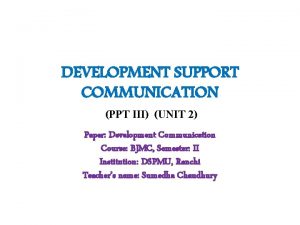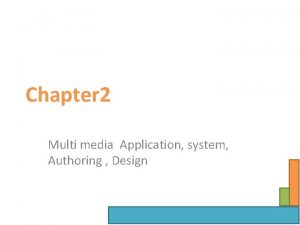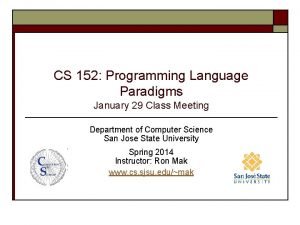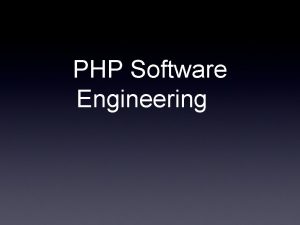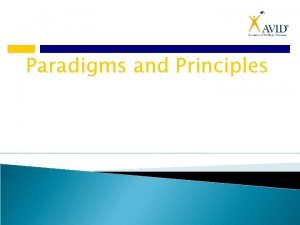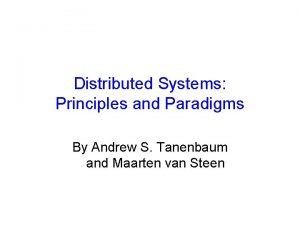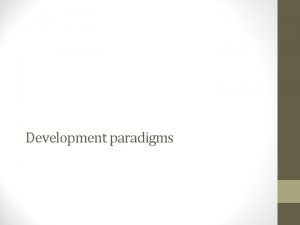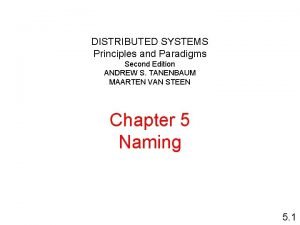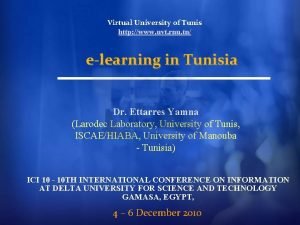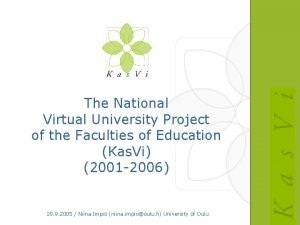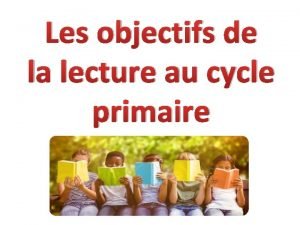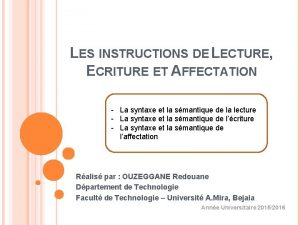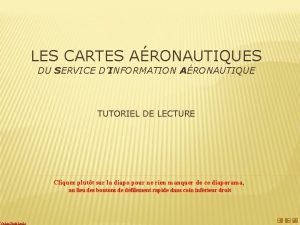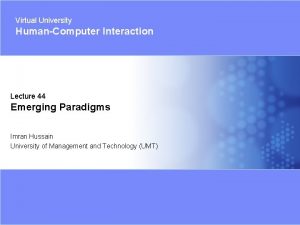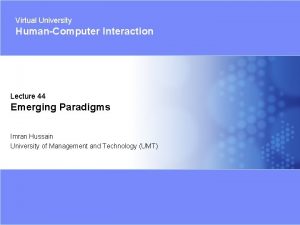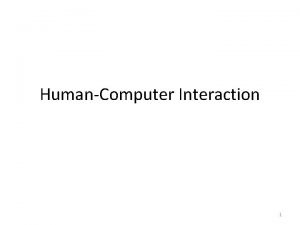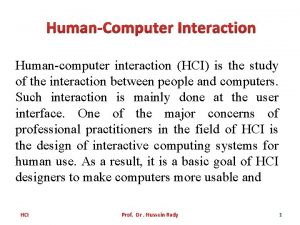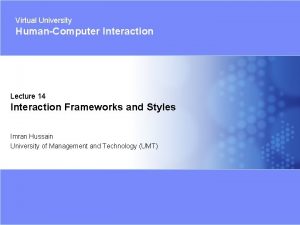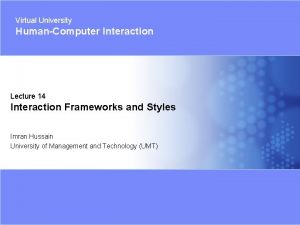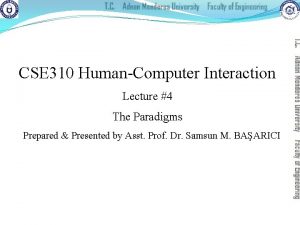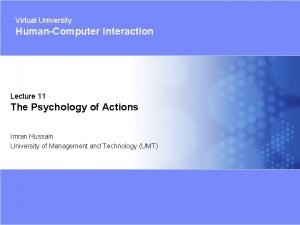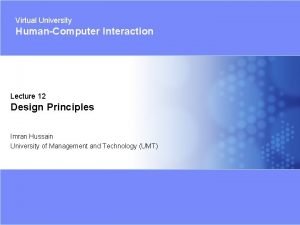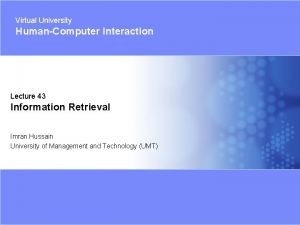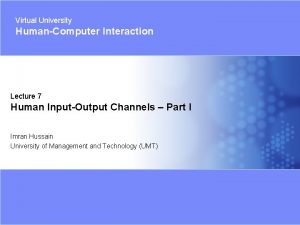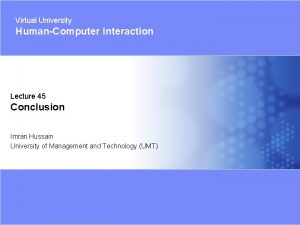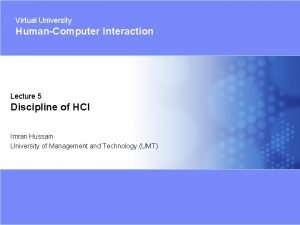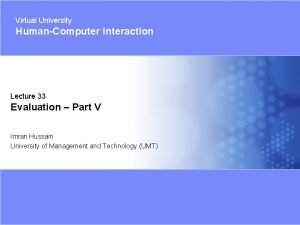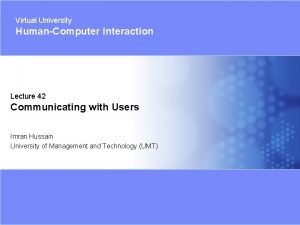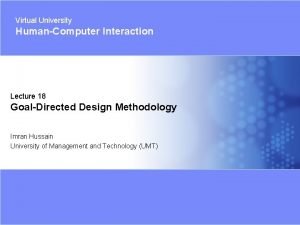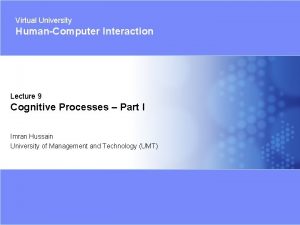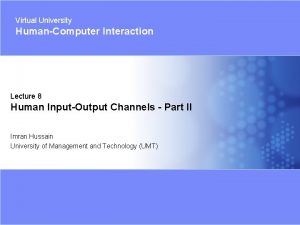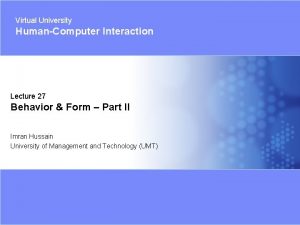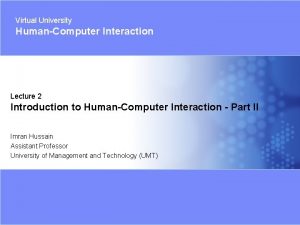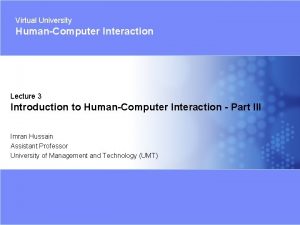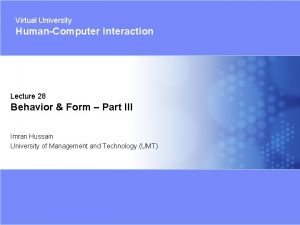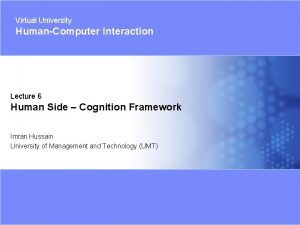Virtual University HumanComputer Interaction Lecture 15 Interaction Paradigms


































































- Slides: 66

Virtual University Human-Computer Interaction Lecture 15 Interaction Paradigms Imran Hussain University of Management and Technology (UMT) 1 Virtual University - Human Computer Interaction © Imran Hussain | UMT

In the Last Lecture • Interaction – Models of Interactionn • Ergonomics – physical aspects of interfaces – industrial interfaces • Common Interaction Styles – – – 2 command line interface menus natural language question/answer and query dialogue form-fills and spreadsheets Virtual University - Human Computer Interaction © Imran Hussain | UMT

In Today’s Lecture • Elements of WIMP interfaces • What are Paradigms • Paradigms of Interaction • Paradigm shifts (example) – – – – 3 Batch processing Timesharing Networking Graphical display Microprocessor WWW Ubiquitous Computing Virtual University - Human Computer Interaction © Imran Hussain | UMT

Elements of the WIMP Interface • windows, icons, menus, pointers • buttons, toolbars, • palettes, dialog boxes 4 Virtual University - Human Computer Interaction © Imran Hussain | UMT

Windows • Areas of the screen that behave as if they were independent – can contain text or graphics – can be moved or resized – can overlap and obscure each other, or can be laid out next to one another (tiled) 5 Virtual University - Human Computer Interaction © Imran Hussain | UMT

Windows • scrollbars • title bars 6 Virtual University - Human Computer Interaction © Imran Hussain | UMT

Icons • small picture or image • represents some object in the interface – often a window or action • windows can be closed down (iconised) – small representation fi many accessible windows • icons can be many and various – highly stylized – realistic representations. 7 Virtual University - Human Computer Interaction © Imran Hussain | UMT

Pointers • important component – WIMP style relies on pointing and selecting things • uses mouse, trackpad, joystick, trackball, cursor keys or keyboard shortcuts • wide variety of graphical images 8 Virtual University - Human Computer Interaction © Imran Hussain | UMT

Menus • Choice of operations or services offered on the screen • Required option selected with pointer 9 Virtual University - Human Computer Interaction © Imran Hussain | UMT

Menus problem – take a lot of screen space solution – pop-up: menu appears when needed 10 Virtual University - Human Computer Interaction © Imran Hussain | UMT

Kinds of Menus • Menu Bar at top of screen (normally), menu drags down – pull-down menu - mouse hold and drag down menu – drop-down menu - mouse click reveals menu – fall-down menus - mouse just moves over bar! • Contextual menu appears where you are – pop-up menus - actions for selected object – pie menus - arranged in a circle • easier to select item (larger target area) • quicker (same distance to any option) … but not widely used! 11 Virtual University - Human Computer Interaction © Imran Hussain | UMT

Pull-down Menu 12 Virtual University - Human Computer Interaction © Imran Hussain | UMT

Drop-down Menu 13 Virtual University - Human Computer Interaction © Imran Hussain | UMT

Fall-down Menus 14 Virtual University - Human Computer Interaction © Imran Hussain | UMT

Pop-up Menus 15 Virtual University - Human Computer Interaction © Imran Hussain | UMT

Pie Menu 16 Virtual University - Human Computer Interaction © Imran Hussain | UMT

Menus Extras • Cascading menus – hierarchical menu structure – menu selection opens new menu – and so in ad infinitum • Keyboard accelerators – key combinations - same effect as menu item – two kinds • active when menu open – usually first letter • active when menu closed – usually Ctrl + letter usually different 17 Virtual University - Human Computer Interaction © Imran Hussain | UMT

Keyboard Accelerators Alt + 18 T Virtual University - Human Computer Interaction © Imran Hussain | UMT

Menus Design Issues • which kind to use • what to include in menus at all • words to use (action or description) • how to group items • choice of keyboard accelerators 19 Virtual University - Human Computer Interaction © Imran Hussain | UMT

Buttons • individual and isolated regions within a display that can be selected to invoke an action • Special kinds – radio buttons – set of mutually exclusive choices – check boxes – set of non-exclusive choices 20 Virtual University - Human Computer Interaction © Imran Hussain | UMT

Radio Buttons 21 Virtual University - Human Computer Interaction © Imran Hussain | UMT

Check Boxes 22 Virtual University - Human Computer Interaction © Imran Hussain | UMT

Toolbars • long lines of icons … … but what do they do? • fast access to common actions • often customizable: – choose which toolbars to see – choose what options are on it 23 Virtual University - Human Computer Interaction © Imran Hussain | UMT

Customization 24 Virtual University - Human Computer Interaction © Imran Hussain | UMT

Customization 25 Virtual University - Human Computer Interaction © Imran Hussain | UMT

Palettes and Tear-off Menus • Problem menu not there when you want it • Solution palettes – little windows of actions – shown/hidden via menu option e. g. available shapes in drawing package tear-off and pin-up menus – menu ‘tears off’ to become palette 26 Virtual University - Human Computer Interaction © Imran Hussain | UMT

Palettes and Tear-off Menus 27 Virtual University - Human Computer Interaction © Imran Hussain | UMT

Dialogue Boxes • information windows that pop up to inform of an important event or request information. 28 Virtual University - Human Computer Interaction © Imran Hussain | UMT

Why Study Paradigms? Concerns – how can an interactive system be developed to ensure its usability? – how can the usability of an interactive system be demonstrated or measured? History of interactive system design provides paradigms for usable designs 29 Virtual University - Human Computer Interaction © Imran Hussain | UMT

What are Paradigms • Predominant theoretical frameworks or scientific world views – e. g. , Aristotelian, Newtonian, Einsteinian (relativistic) paradigms in physics • Understanding HCI history is largely about understanding a series of paradigm shifts – Not all listed here are necessarily “paradigm” shifts, but are at least candidates – History will judge which are true shifts 30 Virtual University - Human Computer Interaction © Imran Hussain | UMT

Interaction Paradigms • Informs design of a conceptual model • A particular philosophy or way of thinking about interaction design – E. g. , designing applications for the desktop environment 31 Virtual University - Human Computer Interaction © Imran Hussain | UMT

Paradigms of Interaction New computing technologies arrive, creating a new perception of the human—computer relationship. We can trace some of these shifts in the history of interactive technologies. 32 Virtual University - Human Computer Interaction © Imran Hussain | UMT

The Initial Paradigm • Batch processing Impersonal computing 33 Virtual University - Human Computer Interaction © Imran Hussain | UMT

Example Paradigm Shifts • Batch processing • Time-sharing Interactive computing 34 Virtual University - Human Computer Interaction © Imran Hussain | UMT

Example Paradigm Shifts • Batch processing • Timesharing • Networking @#$% ! Community computing 35 Virtual University - Human Computer Interaction © Imran Hussain | UMT

Example Paradigm Shifts • • Batch processing Timesharing Networking Graphical displays C…P… filename dot star… or was it R…M? Move this file here, and copy this to there. % foo. bar ABORT dumby!!! Direct manipulation 36 Virtual University - Human Computer Interaction © Imran Hussain | UMT

Example Paradigm Shifts • • • Batch processing Timesharing Networking Graphical display Microprocessor Personal computing 37 Virtual University - Human Computer Interaction © Imran Hussain | UMT

Example Paradigm Shifts • • • Batch processing Timesharing Networking Graphical display Microprocessor WWW Global information 38 Virtual University - Human Computer Interaction © Imran Hussain | UMT

Example Paradigm Shifts • • 39 Batch processing • A symbiosis of physical and electronic worlds in service Timesharing of everyday activities. Networking Graphical display Microprocessor WWW Ubiquitous Computing Virtual University - Human Computer Interaction © Imran Hussain | UMT

User Productivity “Where are We Now? ” ? WIMP (Windows) Command Line Batch 1940 s – 1950 s 1960 s – 1970 s 1980 s - Present ? Time 40 Virtual University - Human Computer Interaction © Imran Hussain | UMT

Time-sharing • 1940 s and 1950 s – explosive technological growth • 1960 s – need to channel the power • J. C. R. Licklider at ARPA • single computer supporting multiple users 41 Virtual University - Human Computer Interaction © Imran Hussain | UMT

Innovator: J. R. Licklider 42 • 1960 - Postulated “man-computer symbiosis” • Couple human brains and computing machines tightly to revolutionize information handling Virtual University - Human Computer Interaction © Imran Hussain | UMT

Video Display Units • more suitable medium than paper • 1962 – Sutherland's Sketchpad • computers for visualizing and manipulating data • one person's contribution could drastically change the history of computing Ivan Sutherland • Sketchpad - ‘ 63 Ph. D thesis at MIT §Hierarchy - pictures & sub pictures §Master picture with instances (i. e. , OOP) §Constraints §Icons §Copying §Light pen as input device §Recursive operations 43 Virtual University - Human Computer Interaction © Imran Hussain | UMT

Programming toolkits • Engelbart at Stanford Research Institute • 1963 – augmenting man's intellect • 1968 NLS/Augment system demonstration • the right programming toolkit provides building blocks to producing complex interactive systems 44 Virtual University - Human Computer Interaction Douglas Englebart Inventor of mouse © Imran Hussain | UMT

About Doug Engelbart • Graduate of Berkeley (EE '55) – "bi-stable gaseous plasma digital devices" • Stanford Research Institute (SRI) – Augmentation Research Center • 1962 Paper "Conceptual Model for Augmenting Human Intellect" – Complexity of problems increasing – Need better ways of solving problems Picture of Engelbart from bootstrap. org 45 Virtual University - Human Computer Interaction © Imran Hussain | UMT

Personal computing • 1970 s – Papert's LOGO language for simple graphics programming by children • A system is more powerful as it becomes easier to user • Future of computing in small, powerful machines dedicated to the individual • Kay at Xerox PARC – the Dynabook as the ultimate personal computer 46 Virtual University - Human Computer Interaction Alan Kay Dynabook - Notebook sized computer loaded with multimedia and can store everything © Imran Hussain | UMT

Window systems and the WIMP interface • humans can pursue more than one task at a time • windows used for dialogue partitioning, to “change the topic” • Xerox PARC - mid 1970’s – Alto • local processor, bitmap display, mouse • Precursor to modern GUI, windows, menus, scrollbars • LAN - Ethernet 47 Virtual University - Human Computer Interaction © Imran Hussain | UMT

Window systems and the WIMP interface • 1981 – Xerox Star first commercial windowing system • windows, icons, menus and pointers now familiar interaction mechanisms 48 Virtual University - Human Computer Interaction © Imran Hussain | UMT

Metaphor • relating computing to other real-world activity is effective teaching technique – – – LOGO's turtle dragging its tail file management on an office desktop word processing as typing financial analysis on spreadsheets virtual reality – user inside the metaphor • Problems – some tasks do not fit into a given metaphor – cultural bias 49 Virtual University - Human Computer Interaction © Imran Hussain | UMT

Direct manipulation • 1982 – Shneiderman describes appeal of graphically-based interaction – – – visibility of objects incremental action and rapid feedback reversibility encourages exploration syntactic correctness of all actions replace language with action • 1984 – Apple Macintosh • the model-world metaphor • What You See Is What You Get (WYSIWYG) 50 Virtual University - Human Computer Interaction © Imran Hussain | UMT

Language versus Action • actions do not always speak louder than words! • DM – interface replaces underlying system • language paradigm • interface as mediator • interface acts as intelligent agent • programming by example is both action and language 51 Virtual University - Human Computer Interaction © Imran Hussain | UMT

Hypertext • 1945 – Vannevar Bush and the memex • key to success in managing explosion of information • mid 1960 s – Nelson describes hypertext as non-linear browsing structure • hypermedia and multimedia • Nelson's Xanadu project still a dream today 52 Virtual University - Human Computer Interaction © Imran Hussain | UMT

Innovator: Vannevar Bush • “As We May Think” - 1945 Atlantic Monthly – “…publication has been extended far beyond our present ability to make real use of the record. ” • Postulated Memex device – Stores all records/articles/communications – Items retrieved by indexing, keywords, cross references (now called hyperlinks) – (Envisioned as microfilm, not computer) • • 53 Interactive and nonlinear components are key http: //www. theatlantic. com/unbound/flashbks/computer/bushf. htm Virtual University - Human Computer Interaction © Imran Hussain | UMT

More About Vannevar Bush • • Name rhymes with "Beaver" Faculty member MIT Coordinated WWII effort Social contract for science with 6000 US scientists – federal government funds universities – universities do basic research – research helps economy & national defense 54 Virtual University - Human Computer Interaction © Imran Hussain | UMT

Innovator: Ted Nelson • Computers can help people, not just business • Coined term “hypertext” 55 Virtual University - Human Computer Interaction © Imran Hussain | UMT

Multimodality • a mode is a human communication channel • emphasis on simultaneous use of multiple channels for input and output 56 Virtual University - Human Computer Interaction © Imran Hussain | UMT

Computer Supported Cooperative Work (CSCW) • CSCW removes bias of single user / single computer system • Can no longer neglect the social aspects • Electronic mail is most prominent success 57 Virtual University - Human Computer Interaction © Imran Hussain | UMT

The World Wide Web • Hypertext, as originally realized, was a closed system • Simple, universal protocols (e. g. HTTP) and mark-up languages (e. g. HTML) made publishing and accessing easy • Critical mass of users lead to a complete transformation of our information economy. 58 Virtual University - Human Computer Interaction © Imran Hussain | UMT

Agent-based Interfaces • Original interfaces – Commands given to computer – Language-based • Direct Manipulation/WIMP – Commands performed on “world” representation – Action based • Agents - return to language by instilling proactivity and “intelligence” in command processor – Avatars, natural language processing 59 Virtual University - Human Computer Interaction © Imran Hussain | UMT

Examples of new paradigms • • • Ubiquitous computing (mother of them all) Pervasive computing Wearable computing Tangible bits, augmented reality Attentive environments Transparent computing – and many more…. 60 Virtual University - Human Computer Interaction © Imran Hussain | UMT

Ubiquitous Computing The most profound technologies are those that disappear. ” Mark Weiser, 1991 Late 1980’s: computer was very apparent How to make it disappear? – Shrink and embed/distribute it in the physical world – Design interactions that don’t demand our intention 61 Virtual University - Human Computer Interaction © Imran Hussain | UMT

Ubiquitous Computing “The most profound technologies are those that disappear. They weave themselves into the fabric of everyday life until they are indistinguishable from it. ” Mark Weiser, 1991 Late 1980’s: computer was very apparent How to make it disappear? – Shrink and embed/distribute it in the physical world – Design interactions that don’t demand our intention • 62 Aka pervasive computing Virtual University - Human Computer Interaction © Imran Hussain | UMT

Innovator: Mark Weiser • Introduced notion of Ubiquitous Computing and Calm Technology – It’s everywhere, but recedes quietly into background • CTO of Xerox PARC 63 Virtual University - Human Computer Interaction © Imran Hussain | UMT

Sensor-based and Context-aware Interaction • Humans are good at recognizing the “context” of a situation and reacting appropriately • Automatically sensing physical phenomena (e. g. , light, temp, location, identity) becoming easier • How can we go from sensed physical measures to interactions that behave as if made “aware” of the surroundings? 64 Virtual University - Human Computer Interaction © Imran Hussain | UMT

Wearables • New interaction paradigms – Ubiquitous computing (technology embedded in the environment) • Computers disappear into the environment so you are no longer aware of them and use them without thinking • Extends human capabilities – Pervasive computing (seamless integration of technology), e. g. , smart devices (designed for particular activity) cell phones, PDAs, fridges – Wearable computing (or wearables) 65 Virtual University - Human Computer Interaction © Imran Hussain | UMT

Augmented Reality • New interaction paradigms – Tangible bits, augmented reality, and physical/virtual integration • Combine digital info with physical objects – E. g. , greeting card with digital animation – Attentive environments and transparent computing • Computers attend to user’s needs – Anticipate what users want to do, e. g. , detect where people are looking and decide what to display (GAP store in Minority Report – Tom Cruise) 66 Virtual University - Human Computer Interaction © Imran Hussain | UMT
 Paradigm of interaction in hci
Paradigm of interaction in hci 01:640:244 lecture notes - lecture 15: plat, idah, farad
01:640:244 lecture notes - lecture 15: plat, idah, farad Peter hall policy paradigms
Peter hall policy paradigms Careershodh
Careershodh Boyfriend/girlfriend centered paradigm
Boyfriend/girlfriend centered paradigm Syntagmatic vs paradigmatic
Syntagmatic vs paradigmatic Distributed systems tanenbaum
Distributed systems tanenbaum Message ordering paradigms
Message ordering paradigms Distributed systems principles and paradigms
Distributed systems principles and paradigms Paradigm of distributed computing
Paradigm of distributed computing 3 paradigms
3 paradigms Interpretivist approach to consumer behavior
Interpretivist approach to consumer behavior Boyfriend/girlfriend centered paradigm
Boyfriend/girlfriend centered paradigm Binding in programming paradigms
Binding in programming paradigms Ktu programming paradigms notes
Ktu programming paradigms notes Paradigms of development communication ppt
Paradigms of development communication ppt Designer released multimedia authoring system
Designer released multimedia authoring system Quick and dirty evaluation
Quick and dirty evaluation Biological paradigm of psychopathology
Biological paradigm of psychopathology R programming language paradigms
R programming language paradigms Php features and paradigms
Php features and paradigms Paradigms and principles
Paradigms and principles Distributed systems principles and paradigms
Distributed systems principles and paradigms Paradigms of development
Paradigms of development Distributed systems principles and paradigms
Distributed systems principles and paradigms Has virtual functions and accessible non-virtual destructor
Has virtual functions and accessible non-virtual destructor Virtual university mba
Virtual university mba Virtual pathology at the university of leeds
Virtual pathology at the university of leeds Vutes
Vutes Elearning uvt
Elearning uvt National virtual university
National virtual university 1886 modern compound light microscope
1886 modern compound light microscope 沈榮麟
沈榮麟 Project procurement management lecture notes
Project procurement management lecture notes Lecture about sport
Lecture about sport Healthy lifestyle wrap up lecture
Healthy lifestyle wrap up lecture Existentialism vs nihilism
Existentialism vs nihilism Meaning of this
Meaning of this Randy pausch the last lecture summary
Randy pausch the last lecture summary Tensorflow lecture
Tensorflow lecture Theology proper lecture notes
Theology proper lecture notes Strategic management lecture
Strategic management lecture Geology lecture series
Geology lecture series Social psychology lecture
Social psychology lecture In text citation for a lecture
In text citation for a lecture Public sector accounting pdf notes
Public sector accounting pdf notes Project management for software development
Project management for software development Practical design to eurocode 2 lecture 3
Practical design to eurocode 2 lecture 3 Magnetism
Magnetism Classical mechanics
Classical mechanics Physics 101 lecture notes pdf
Physics 101 lecture notes pdf Physical science lecture notes
Physical science lecture notes Power system dynamics and stability lecture notes
Power system dynamics and stability lecture notes Natural language processing nlp - theory lecture
Natural language processing nlp - theory lecture Microbial physiology notes
Microbial physiology notes Mechatronics lecture notes ppt
Mechatronics lecture notes ppt Ternology
Ternology Types de lecture au primaire
Types de lecture au primaire Instruction de lecture
Instruction de lecture Aronautique
Aronautique Lecture title
Lecture title Lecture presentations for campbell biology
Lecture presentations for campbell biology Financial engineering lecture notes
Financial engineering lecture notes Current components in bjt
Current components in bjt Requirement analysis in software engineering notes
Requirement analysis in software engineering notes Extension lecture meaning
Extension lecture meaning La situation de passage du dernier jour d'un condamné
La situation de passage du dernier jour d'un condamné


